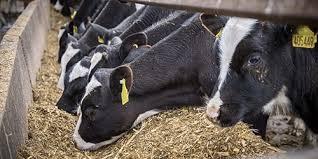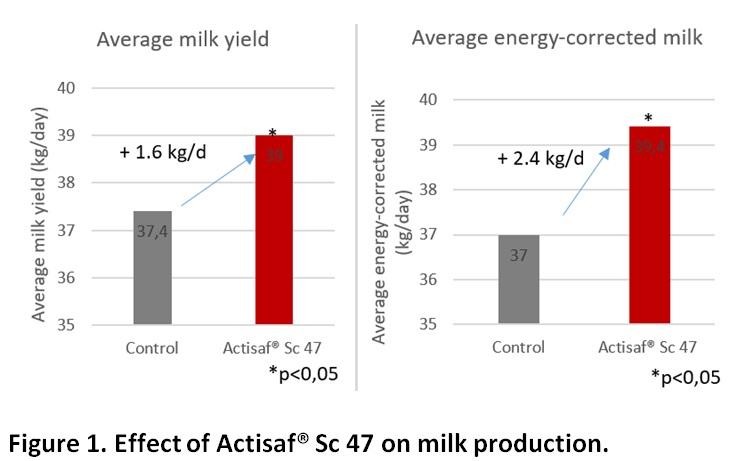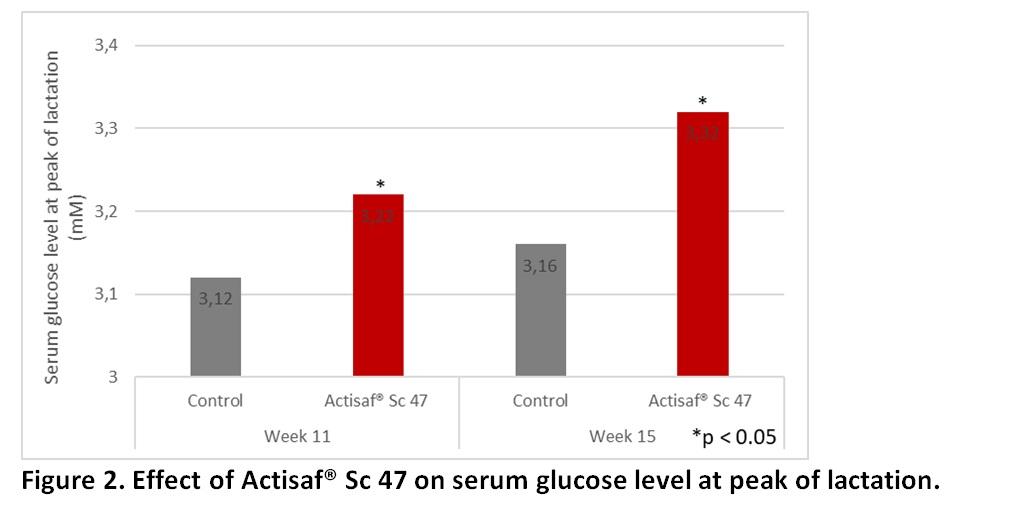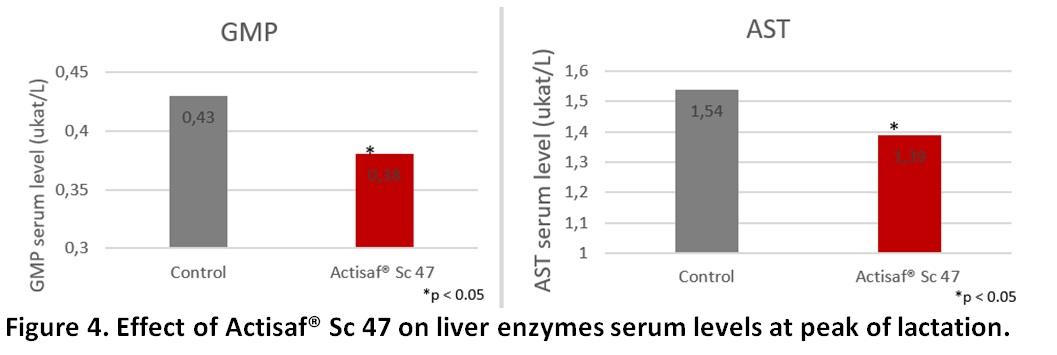Yeast probiotic Actisaf® Sc 47 boosts milk production in early-lactation dairy cows
Published: July 8, 2020
By: Mohamed Mammeri, PhD, Global Product Manager, Phileo by Lesaffre & Valentin Nenov, PhD, Global Ruminant Manager, Phileo by Lesaffre.

Early-lactation dairy cows have high energy demand for milk production. Often the energy intake in this period is not enough to meet their requirements and the cows often face negative energy balance that may lead to metabolic disorders with long lasting negative effect on both productivity and health. To meet this increasing energy demand, we often formulate high energy diets with increased starch content. Those diets, however, can have negative impact on the rumen fermentation and often cause subclinical acidosis that further reduces the energy intake.
The efficacy of the yeast probiotic Actisaf® Sc 47 in early lactating dairy cows fed high starch diet was reported recent published study (Kumprechtová et al., 2019). Actisaf® Sc 47 supplementation increased milk yield by 4% and energy corrected milk by 6% while having positive effect on metabolic parameters.
The trial, based in a commercial dairy farm in Czech Republic, was designed to evaluate the effect of supplementing Actisaf® Sc 47 on the performance and metabolic status of early lactating dairy cows fed high starch diet.
50 high-yielding cows from a herd of 430 Holstein crossbreds were placed in an experimental free-stall pens three weeks after calving and randomly assigning into two groups of 25 cows each: control and supplemented.
The control group were fed a basal total mixed ration (TMR) while the supplemented group was given the same basal TMR, plus Actisaf® Sc 47 which was fed at 5 grams per cow per day (5 x 1010 CFU/c/d). The trial ran from 3 to 19 weeks in lactation with milk yields being recorded each day for each cow.
Energy-corrected milk production was calculated according to approved milk, fat and protein standards while rumen fermentation and serum metabolic profile readings were taken from eight cows per group at 3, 7, 11, 15, and 19 weeks post-partum.
Ruminal content was analysed for pH, total volatile fatty acids (VFA) and lactate content while the sera was analysed for glucose, non-esterified fatty acids (NEFA), beta-hydroxybutyrate (BHBA), aspartate Aminotransferase (AST), gamma-glutamyl transferase (GMP).
Results showed mean rumen pH, recorded 4 hours after morning feeding, and VFA, being significantly higher in the supplemented cows, while ruminal lactate was significantly lower (Table 1). This led to the conclusion that Actisaf® Sc 47 helped to reduce the risk of acidosis that occurs in cows which are fed higher concentrate levels in the basal diet. In addition, the improvement in ruminal fermentation within the Actisaf® Sc 47 group, alongside higher VFA production in the rumen, was seen as having created an increased energy supply to help boost milk production.
 Cows receiving Actisaf® Sc 47 showed significant increases in both daily milk yield (+1.6 Kg/cow/d; p < 0.05), and ECM ((+2.4 Kg/cow/d; p < 0.05) (Figure 1). In addition, both milk protein and fat content were numerically greater in the group supplemented with Actisaf® Sc 47.
Cows receiving Actisaf® Sc 47 showed significant increases in both daily milk yield (+1.6 Kg/cow/d; p < 0.05), and ECM ((+2.4 Kg/cow/d; p < 0.05) (Figure 1). In addition, both milk protein and fat content were numerically greater in the group supplemented with Actisaf® Sc 47.
The significantly increased serum glucose levels, alongside reduced BHBA, NEFA, and serum activity for both liver enzymes, AST and GMP, reflects a reduction in lipomobilization processes and hepatic ketogenesis in the Actisaf® Sc 47 group at the peak of lactation (Figures 2, 3 and 4). This indicates an improvement in energy balance and a reduction in systemic inflammation and the risk of sub clinical ketosis.
Actisaf® Sc 47 supplementation therefore improves both energy status and metabolism, resulting in an increased supply of energy for milk production.



The overall trial conclusion was that Actisaf® Sc 47, given as a daily supplement to high-yielding dairy cows during early lactation, helps to reduce the risk of acidosis by stabilizing the ruminal environment and mitigating negative energy balance. The commercial results of this mode of action are higher milk yields and milk components.
Finally, taking account of the cost of the supplementation, compared with the increased value of the milk that was produced, it was calculated that the return on investment (ROI) from using Actisaf® Sc 47 during the trial was 9:1
Kumprechtová, D., Illek, J., Julien, C., Homolka, P., Jancík, F., Auclair, E., 2019. Effect of live yeast (Saccharomyces cerevisiae ) supplementation on rumen fermentation and metabolic profile of dairy cows in early lactation. J. Anim. Physiol. Anim. Nutr. 103, 447–455. https://doi.org/10.1111/jpn.13048GD
Related topics:
Authors:
Phileo by Lesaffre
Phileo by Lesaffre
Influencers who recommended :
Mohamed Mammeri, Clara Berger and 1 moreRecommend
Comment
Share
Recommend
Reply
25 de agosto de 2021
SIR CAN YOU PLEAS SEND US ANY SAMPLE SO WE CAN TRY THEN WE WILL PLACE ORDER.
THANK YOU
Recommend
Reply
Recommend
Reply
14 de julio de 2020
What is the active role of yeast in acidosis?
Most of the Asian countries fed the animals with more fiber valued feed.
Is it equally effect the Rumen pH in such mix of the ration differences? Will the acisaf work in such situations?
Recommend
Reply

Would you like to discuss another topic? Create a new post to engage with experts in the community.











